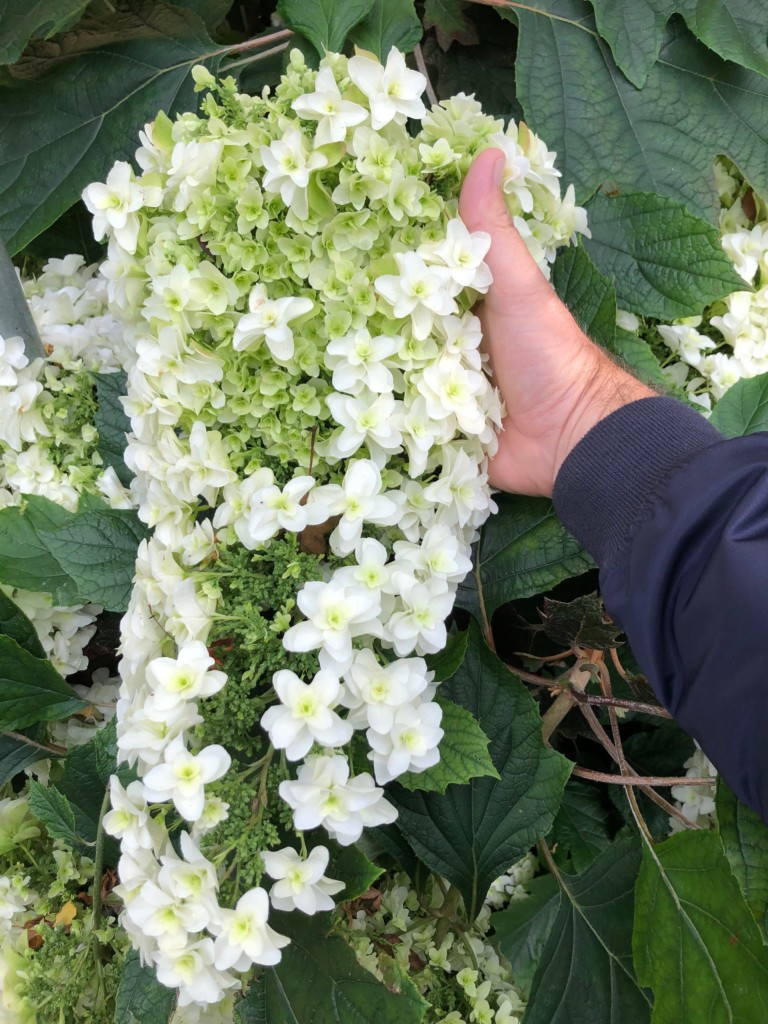I’m wracking my brains, trying to remember my first encounter with Hydrangea quercifolia. Most of us grew up with hydrangeas – the ‘mop-top’ sort – in our Mum’s gardens, or our Nana’s gardens, and it was many years before I came to understand that this broad genus includes shrubs that take hydrangea-hood to undreamed-of places, possibly reaching its exquisite zenith in plants like Hydrangea villosa. But it’s the rare combination of good foliage and fabulous flowers that has lead me, today, to consider the oak-leaf hydrangea, H. quercifolia.
Quercus, being the genus of oaks, is the obvious source of the species name as the leaves of this hydrangea look very like a giant leaf of a pin-oak, or scarlet oak, with somewhat pointed lobes. These alone would make you want to grow this shrub (and indeed, this is often why I choose it, and I make sure it doesn’t flower, but more on that later).
The most luxuriant leaves tend to occur on plants in shade, and with a reasonable amount of water, but the most dramatic bronze/burgundy autumn colour (and it can be brilliant, at best) occurs on plants grown a little tougher, and in more light. They’ll only take so much sun, however, before they start to burn, so if you’re after that autumn glow, its’ a bit of a balancing act, giving them lots of light, but not too much. They’ll certainly want protection from the hottest of summer afternoon sun.
The flowers are something else – panicles forming great cones made up of a spangling of both sterile (and showy) flowers and fertile (non-showy) flowers in cream, slowly being stained with pink, and held aloft by stems covered in cinnamon felt. On the double-flowered form, the very aptly named ‘snowflake’, individual flowers are multi-layered and the panicles can grow enormous – I mean seriously, implausibly, huge.

But in growing Hydrangea quercifolia there’s always a decision to make. It flowers on stems that branch off wood produced last year, but the foliage is always neatest and tightest on plants pruned very hard over winter (and that therefore don’t flower, having had all of last year’s wood removed). I’m usually clear, according to context, about which of these aspects I want to feature, and prune accordingly. At times I’ve experimented with pruning all the front of a plant back quite hard, and leaving a few stems at the back unpruned. It kind of works. But when it’s leaves I’m after, I always want that tight dome of fresh foliage, and that’s only possible be sacrificing the flowers and pruning it hard.
Having decided I like my hydrangeas tight and dense, back in 2012 I stumbled on two huge potted plants in a villa just outside of Lucca, Italy (see leading image), holding themselves with a dignity of which I didn’t think this plant was capable. It was well into autumn, and the flowers were past their best, but they were held high (being uncharacteristically tall, unpruned plants, and with added elevation provided by their pots) in such a way that the sun penetrating the overlapping brown papery bracts made a perfect four-pointed star. I saw the plant in a whole new light that day.

The choice of pruning regime also dictates this plant’s sociability. If hard-pruned, you can cover the ground beneath it with smaller spring bulbs, or early woodland perennials like violets or primroses, which will flower when the hydrangea is nothing but stumps, and then quietly recede into dormancy as the hydrangea clothes itself in those unsurpassable leaves. Left unpruned, Hydrangea quercifolia can hold on to some of its foliage, and will leaf up much earlier in spring, narrowing (but not entirely eliminating) the window of opportunity for something else to be flowering in the space it’ll eventually, and beautifully, consume.
Just goes to show in horticulture we just keep learning — how marvellous and what a wonderful leading image. Love it. I have just planted 8 hydrangeas in my Dandenong Ranges garden because I feel they belong, yes old fashioned moptops (but new cultivars) and my favourite, lacecaps. I even planted one red/pink one in a pot so I can control the colour from changing to blue in my slightly acid soil. Saw a program on TV with a courtyard in Greece and lots of these reddish wonders. I was sold!